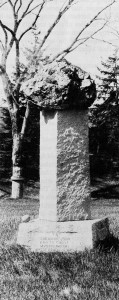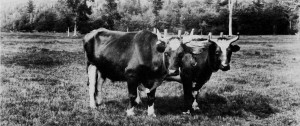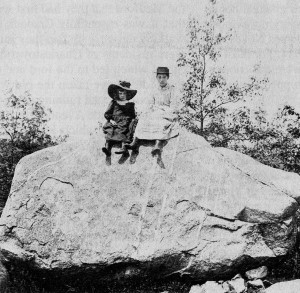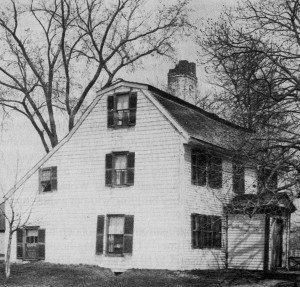Of the many employees Cradock sent over to conduct his business, some went to Marblehead, some to Ipswich, some to Agawam, some even went up to Kennebunk, but a small contingent settled on land in Medford which later was formally granted to Cradock by the government.

Early in the summer of 1629 three young men, the Sprague brothers, just arrived in Salem from old England, set off on foot to explore the countryside. With some friends they took the old “Indian” path across the Saugus plains into Malden, then to the edge of the area now called the Middlesex Fells, and down the wooded descent into the present Medford Square. They were making for the ford that crossed the Mystic River just west of Medford Square.
Striding through a country of “stately timbers,” they noted good tall oaks for ships’ masts, mixed with walnut, elm, and plenty of pines. Goodly woods, but fine open lands too, yearly burnt by Native Americans to keep them clear. They saw salt marshes that promised fine hay. By afternoon they reached the ford, where the river was shallow enough for crossing. The party splashed across the Mystic and continued on the “Indian” footpath up present- day Winter Hill and then down to Charlestown peninsula.
The men sent over by the Governor of the Massachusetts Bay Company, Matthew Cradock, London merchant and dedicated Puritan, had not yet staked out a “plantation” for him on the land near the ford. That would happen the next year, 1630, when his successor as governor, John Winthrop, and the thousand folks in the Winthrop fleet reached Salem. They soon moved on to the Shawmut peninsula to settle in Boston. From there they dispersed to establish little towns nearby.
Of the many employees Cradock sent over to conduct his business, some went to Marblehead, some to Ipswich, some to Agawam, some even went up to Kennebunk, but a small contingent settled on land in Medford which later was formally granted to Cradock by the government. As one of the principal investors in the Company, Cradock was entitled to 200 acres for every fifty pounds invested. That he had invested far more than that was evident by the amount of land granted him in Medford alone. On the East it was bounded by land of others near Maiden River, on the South by the Mystic River, on the West by the Mystic Lakes, and on the North by the highlands of the Fells. Most of present-day Medford north of the river belonged to Cradock.
These English intruders were rather casual about giving away land inhabited by the natives. The first dwellers in Medford were the Pawtuckets whose Sachem, or leader, was Nanepashemit. His son, Wonohaquaham, called Sagamore John by the locals, became chief of the Pawtuckets.

In 1631, Thomas Dudley wrote that Sagamore John did not command more than 30-40 men. His lodge occasionally was on the westerly slope of Walnut Tree Hill (now Tufts College Hill) but the Natives often moved. Sometimes his residence was near the weirs at Mystic Pond where the fishing was good. Governor Winthrop reported that Sagamore John and his people died of smallpox in 1633. In 1644, the remaining Native American population in Massachusetts put themselves under the English government. Once there had been about 20,000 Native Americans within fifty miles of Plymouth alone. By the close of the century there were only about 4,000 left in the whole state.
As late as the nineteenth century, it was not uncommon for Medford farmers while plowing to dig up arrow heads and stone drills. In the fall of 1882 workmen digging a cellar hole for Francis Brooks of West Medford discovered the bones of eighteen Native Americans in a sitting position along with pipes and weapons of war. These skeletons were supposed to be Sagamore John and some of his followers. A monument was erected there, ten feet high with a rough boulder on the top inscribed “To Sagamore John and to these Mystic Indians whose bones lie here.” The monument can be seen today in Sagamore Park, West Medford.
An Englishman traveling in the region in 1634 described Medford for his English audience. “The next town is Mistick, which is three miles from Charlestown by land, and a league and half by water. It is seated on the water’s edge very pleasantly: there are not many houses yet. At the head of the river are spacious ponds, whither the ale-wives press to spawn. This being a noted place for that fish, the English resort hither to take them. . . . On the east side is Mr. Cradock’s Plantation, where he had impaled a park where he keeps his cattle until he can store it with deer. Here likewise he is at charges of building ships. Ships without ballast or loading can float down the river.”

Molasses Rock overlooking Fellsway West opposite Almont Street. 1880’s.
Medford was not then a town like other towns in the Bay Colony — Cambridge or Watertown for instance. In these towns a group of settlers had obtained land titles from the General Court, laid out a common, staked out house lots, built a meeting house, and organized a church with a settled minister. Not so in Medford. At this period it was the private plantation of Matthew Cradock; as the documents aptly phrased it, it was a “peculiar,” that is, “private property” in the 17th century meaning of the word.
As a trading venture of Cradock, operated by his agents, the workers engaged in subsistence farming, fishing, and ship building. For these activities, the plantation’s location on the broad tidal Mystic River was ideal. With roads being only paths through the woods, the river became the major thoroughfare for travel. It was as important then as the railroad, the streetcar lines, and the superhighways were to be later. Cradock’s men worked out of a house and “Great Bam” located in the Medford Square area. It was called Meadford House or Mistick House. The Great Barn was one hundred or more feet in length and had a lean-to attached. It was taken down in 1722.
Since Cradock never came to New England, he depended on agents to manage his interests. Sometimes his workers were an unruly lot. Late in the summer of 1630, one of them, Austen Bratcher (or Augustine Bradshaw) was found dead on the Medford farm. The inquest showed that his death had been caused by blows given by Walter Palmer. Palmer was charged with murder, but the court acquitted him. This did not satisfy another worker on the farm, Thomas Fox, who declared that the court had been bribed. Angered, the court ordered Fox whipped.
Cradock’s first agent, Thomas Mayhew, was a cause of grief to Cradock because of his financial extravagances. Bills for unauthorized expenses regularly went to Cradock in London. He could get no accounting from Mayhew. Though Cradock wanted his workers well taken care of, it appears that Mayhew took better care of himself than them. Cradock complained to Winthrop in 1636 that his workers had written that they had nothing to drink but water, while he held in his hand a bill from Mayhew for 300 gallons of red wine, sack, and aqua vitae.

During the 1630’s until Cradock’s death in 1641, the plantation was a busy community. It grew as the colony grew. The men labored at farming, fishing, and shipbuilding. The forest was cut down and huts or log-houses with chimneys of clay bricks were built. Soon there were a number of brick houses built in Medford demonstrating the wealth of those who could afford brick. Three of these house still stand today: the Peter Tufts House, the Johnathan Wade House and part of the structure of the Royall House.
For some years, Cradock’s people traded with the Native Americans for furs and skins. The farmers raised corn and a variety of other produce. They built stone walls and tended their stock. The cattle roamed free but each was marked with its owner’s name and sold in Boston. Swine were also kept. Mowing-ground and tilling fields were fenced. The fishing business was profitable. The General Court had given Winthrop and Cradock in 1634 the right to erect two weirs in the river to trap fish. In 1639 the price of alewives was five shillings per thousand. But by the next decade that trade proved unsuccessful.
Governor John Winthrop had his own “plantation,” a six hundred acre farm called Ten Hills, down river from his friend Cradock. Much later part of this area was added to Medford. Here he built the first ship constructed on the river. Probably Cradock’s men helped with the construction of THE BLESSING OF THE BAY which was launched July 4, 1631. It cost 145 pounds and was a bark of thirty tons.
In 1632 and 1633 Cradock’s men built two ships in Medford, each of one hundred tons. A third ship, the REBECCA, was also constructed, but shipbuilding did not really thrive in Medford until the 19th century. In the seventeenth century ship construction in Medford consisted mainly of small boats, such as lighters, ketches, and fishing craft.
By 1637 Cradock’s men had built the first bridge across the Mystic. It went up where the present Cradock Bridge now spans the river. Fashioned of wood, the bridge was 154 feet and 5 inches long, 10 feet wide, and there was a toll for cattle crossing it.
Why was the bridge so long? The present bridge is less than half that length. However, the level of Medford Square is considerably higher today than it was in the seventeenth century. That side of the river has been walled up and the land filled in. In the seventeenth century it was barely above the river. Frequently the Square area was flooded at high tides. So the bridge had to be longer to reach high land on either side.
Its construction was ingenious. First, a quantity of brush was laid in the mud at right angles to the river. Then large elm logs were laid on the brush lengthwise to the river. The bridge abutment was built on these logs. This was also made out of logs, each course laid in an opposite direction from the one on which it rested. When the abutment was about ten feet high, the span across the river was built and this put the crossing safely above most high tides.
No matter how ingenious the bridge, some people thought it shouldn’t have been built at all as it was a hindrance to boats trying to go beyond it upriver. Many were the disputes about Medford, or Mistick, Bridge. Who should pay for its upkeep? Some of these ended up in the courts, because neighboring towns were assessed for its repair which did not seem fair to them. For more than a hundred years the arguments continued.
This bridge was the only one across the Mystic River until 1787. So for nearly 150 years all traffic north of the river, unless they chose to ford the river or take ferries, had to use this bridge to get in and out of Boston. Travel increased through Medford as people and vehicles were funneled through by the bridge. Many of the travelers left some of their money behind them to enrich Medford merchants, innkeepers, and farmers.
Because all the land around present-day Medford Square was in the hand of one owner during most of this century, no real community center was possible there. Very early a nucleus of houses, farms, and a few shops were clustered near the top of Mann Simond’s hill (now the Judkins Square area.) It was here that the road from the bridge to the inland towns divided, one branch going on to Arlington (then part of Cambridge) and the other going to Woburn. Because it was a unifying center, the first church was built here. However, once land at the Square became available and was sold to individuals, the bridge and the ease of access to the river quickly drew people there. The successive relocations of the parish church toward the square is indicative of the powerful attraction of the bridge.
People who could not afford the bridge toll continued for years to use the free ford. That could cause problems when the tide was running high. Governor Winthrop told the story of a Mr. and Mrs. Dalkin returning home from Cambridge one rainy day in 1644. Seeing the water at flood, the husband persuaded his wife to remain on shore while he ventured across. He barely made it over. He told her not to try it then, but to wait for the tide to go down. However, since it was raining hard, she decided to risk it. The current swept her off her feet. Her husband cried out in horror, whereupon their dog, at their house nearby, bounded out, plunged in, swam to her, and “she caught hold on the dog’s tail,” said Winthrop, which drew her to the shore and safety. Fortunately most crossings of the ford were more prosaic.
While Cradock lived, Medford was a thriving community, but his death in 1641 coincided with the success of the Puritan revolution in England. The prosperity of the Mass Bay colony, which had thrived on the new arrivals from England, instantly declined, as immigration dropped to a trickle. The fishermen, coopers, shipwrights, and wood choppers left the town. Only a few poor folk remained. The population in 1646 was estimated to be fewer than 100 persons.
After Cradock’s death, the plantation passed to Cradock’s heirs. But as they had no intention of coming to the new world, their only interest was in selling the place. In 1644 Edward Collins became their tenant and in 1652 when they decided to sell Medford, he bought the plantation. So Medford continued to be owned by one person.
Collins had come from England to Cambridge where he was a freeman and a deacon of the First Church as well as a representative to the General Court. From 1644 until 1656 he lived in Medford. Then he began to sell off land here.
While Medford was a plantation, there was no town government. Taxes were paid by either Cradock or Collins and they made the decisions. But when Collins sold land to new people, they wanted a share in governing the plantation. So they met informally in private homes to conduct community business. Meetings were held between 1660-1674 in this fashion. The first records begin in 1674. Medford was never formally incorporated as a town, but the General Court did grant it in 1684 the “powers as other towns as to prudentials” (which meant raising money). In 1674 the first Board of Selectmen was elected and in 1689 Peter Tufts was chosen as the Representative from Medford to the General Court. Other officers filled during these years were surveyors of highways, a tything-man, a town clerk, and fence-viewers. Town government had finally come to Cradock’s plantation.
With it came taxes. These were collected by the constable. For a while these could be paid in “country pay.” That meant payment in beaver, grain, cattle, fish, and lumber. Medford residents were taxed to support Harvard College too: “Each family was required to send one peck of corn annually, for the support of poor students.” After 1694 the government no longer accepted such payment in kind.
The first tax in 1630 was for the military instruction of the male citizens. It was paid in 1632 and 1633. In 1631 the General Court ordered that “there shall be a general training of them that inhabit Charlestown, Mistick and the new town.” Cradock was fined three pounds because some of his men failed to attend training. In these early years Cradock’s men were often so busy with work that they found it difficult to take time for their military duties so the General Court released them from such obligations. Yet they were advised to bear arms for their protection.
During the Pequod War in 1637 Medford sent one man to the army. In 1658, Medford men were allowed to train with those of Cambridge instead of with those of Charlestown. By 1675 they could train in Medford under a sergeant appointed by the Major. During the various “Indian” wars they did their share in protecting the colony. They paid the necessary taxes for defense and served in a number of battles. Jonathan Wade was made Captain in the “Three County Troop” which was active in the King Philip’s War in 1677.
Since there were no public schools in Medford during the seventeenth century, taxes for them were not collected. All instruction was given at home and the curriculum was the Bible. The first pastor and teacher was the Reverend James Noyes, an Oxford graduate, who apparently served only in 1634. Since there were not enough people or money to support either a pastor or a meetinghouse, locals worshiped in nearby communities such as Cambridge, Maiden, or Charlestown.
In 1690, a room was hired for religious services and the pulpit was served by students from Harvard College. In 1692 a Reverend John Hancock became the preacher but he served only briefly. Then the town again turned to Harvard for preachers. That same year it was voted to build Medford’s first meeting-house, but the building was not finished until 1696. It was erected “on a rock on the north side of Woburn road” on the top of Marm Simond’s hill. A one-story building without a spire or a gallery cost sixty pounds.
Seats for the congregation were wooden backless benches. The walls were “plaistered with lime.” The meeting-house was used for about twenty years. Between 1698 and 1710 the Reverend Benjamin Woodbridge was the minister but it was not a happy experience for either minister or flock. Their differences had to be settled through various law suits.
It was not easy to be a Puritan. Medford did not hang any witches, but it did punish sinners. Peter Brooks, for example, had to spend two days in the public stocks for “combing his hair on the Sabbath morning.” Nor was it easy not to be a Puritan. In 1692 “two families of those ungodly people called Quakers” came to Medford. They were not welcomed. Instead they were “Ducked in the Mystic River, imprisoned for seven days,” and “ridden out of town on a rail.” The clerk added his opinion to the records: “Served ’em right.”
There were some slaves in Medford during this century. While Cradock ran the plantation there were none but when Collins owned it there were several slaves. In 1655 his slave Elline was whipped and two years later two of his other slaves were also whipped. In the estate of Major Jonathan Wade there were five blacks valued at 97 pounds. Other citizens also had slaves.
There were no cemeteries in the early years and burials were made on an individual’s own property. The first mention of a burying-place was in 1689 after the death of Major Jonathan Wade. This plot of land became the nucleus of the Salem Street Burying Ground.
Excerpted From Medford on the Mystic. By Carl Seaburg and Alan Seaburg. Published by The Medford Historical Society, April 1980. With edits by Kyna Hamill July 2017
